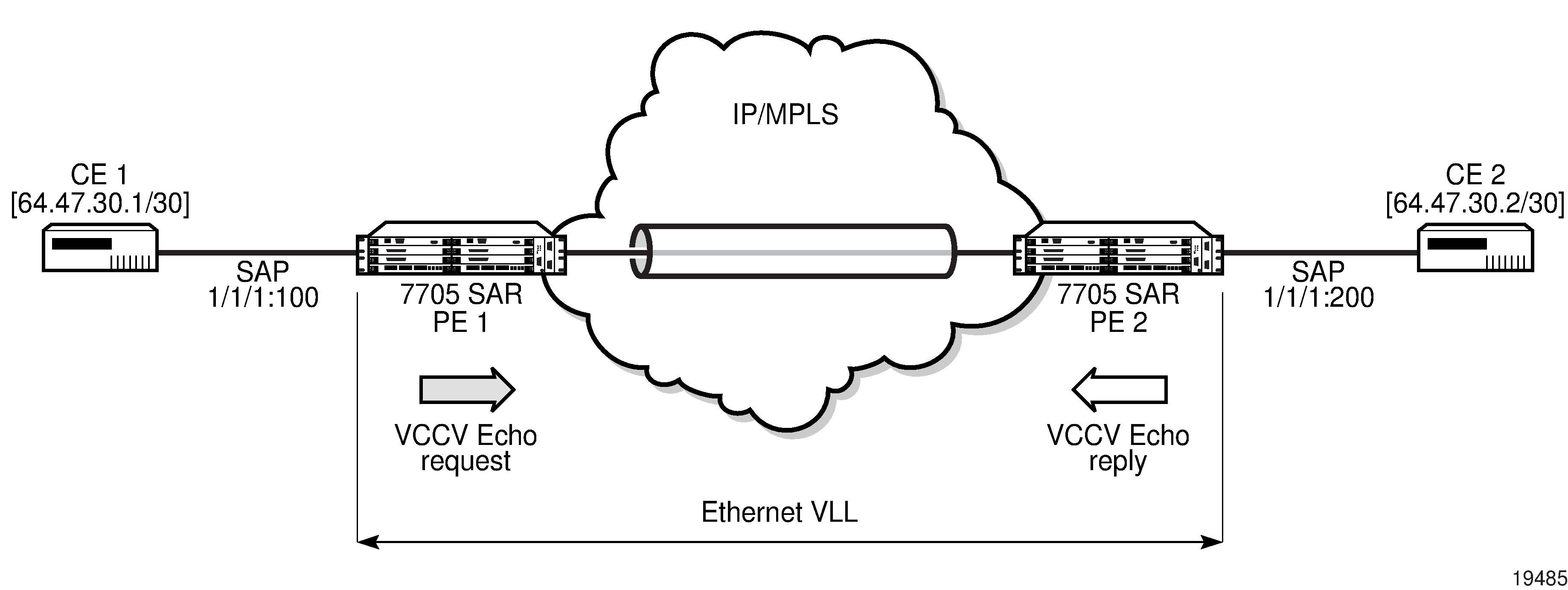VCCV creates an IP control channel within the pseudowire between PE1 and PE2 (see Figure: VCCV Ping Application). PE2 should be able to distinguish, on the receive side, VCCV control messages from user packets on that VLL.

VCCV-based pseudowire (PW) tests are only supported on dynamically signaled PWs (not on statically signaled PWs).
There are three methods of encapsulating a VCCV message in a VLL, which translates into three types of control channels, as follows:
Type 1 — in-band VCCV (special control word)
Type 1 uses the OAM control word, which is shown in Figure: OAM Control Word Format.
Figure: OAM Control Word Format
In Figure: OAM Control Word Format, the first nibble is set to 0x1. The Format ID and the Reserved fields are set to 0 and the Channel Type is the code point associated with the VCCV IP control channel, as specified in the PWE3 IANA registry [RFC 4446]. The channel type value of 0x21 indicates that the Associated Channel carries an IPv4 packet.
The use of the OAM control word assumes that the draft-martini control word is also used for the user packets. This means that if the control word is optional for a VLL and is not configured, the 7705 SAR PE node will only advertise the router alert label as the CC capability in the Label Mapping message.
This method is supported by the 7705 SAR.
Type 2 — out-of-band VCCV (router alert above the service label)
The 7705 SAR uses the router alert label immediately above the VC label to identify the VCCV ping message. This method has a drawback in that if ECMP is applied to the outer LSP label, such as the transport label, the VCCV message will not follow the same path as the user packets. This effectively means it will not troubleshoot the appropriate path.
This method is supported by the 7705 SAR when a 7750 SR node acts as an LSR in the core of the network. If a 7705 SAR acts as an LSR in the core of the network, the VCCV type 2 message will instead follow the data path.
Type 3 — TTL expiry VCCV (service label TTL = 1 and special control word)
This method is not supported by the 7705 SAR.
When sending the label mapping message for the VLL, PE1 and PE2 must indicate which of the above OAM packet encapsulation methods (that is, which control channel type) they support. This is accomplished by including an optional VCCV TLV in the PW FEC interface parameter field. The format of the VCCV TLV is shown in Figure: VCCV TLV.
The absence of the optional VCCV TLV in the Interface parameters field of the pseudowire FEC indicates that the PE has no VCCV capability.

In Figure: VCCV TLV, the Control Channel (CC) Type field is a bit mask used to indicate if the PE supports none, one, or many control channel types:
0x00 — none of the following VCCV control channel types (Type 1, Type 2, or Type 3) are supported
0x01 — (Type 1, in-band) PWE3 OAM control word (see Figure: OAM Control Word Format)
0x02 — (Type 2, out-of-band) MPLS router alert label
0x04 — (Type 3, not supported on the 7705 SAR) MPLS inner label TTL = 1
If both PE nodes support more than one of the CC types, a 7705 SAR PE will make use of the CC type with the lowest type value. For instance, OAM control word (0x01) will be used in preference to the MPLS router alert label (0x02).
The Connectivity Verification (CV) Type field is a bit mask used to indicate the specific type of VCCV packets to be sent over the VCCV control channel. The possible values supported on the 7705 SAR are:
0x00 — none of the following VCCV packet types are supported
0x02 — LSP ping
This value (0x02) is used in the VCCV ping application and applies to a VLL over an MPLS, GRE, or IP SDP.
A VCCV ping is an LSP echo request message as defined in RFC 4379. It contains a Layer 2 FEC stack TLV in which it must include the sub-TLV type 10 FEC 128 pseudowire. It also contains a field that indicates to the destination PE which reply mode to use:
do not reply
This mode is supported by the 7705 SAR.
reply by an IPv4 UDP packet
This mode is supported by the 7705 SAR.
reply via an IPv4 UDP packet with router alert
This mode is not supported by the 7705 SAR.
Note:This mode, which sets the router alert bit in the IP header, should not be confused with the CC type that makes use of the router alert label.
reply by application-level control channel
This mode sends the reply message in-band over the pseudowire from PE2 to PE1. PE2 will encapsulate the echo reply message using the CC type negotiated with PE1.
This mode is supported by the 7705 SAR.
The VCCV ping reply has the same format as an LSP echo reply message as defined in RFC 4379. The message is sent via the reply mode requested by PE1. The return codes supported are the same as those currently supported in the 7705 SAR LSP ping capability.
The VCCV ping feature is in addition to the service ping OAM feature that can be used to test a service between 7705 SAR nodes. The VCCV ping feature can test connectivity of a VLL with any third-party node that is compliant with RFC 5085.